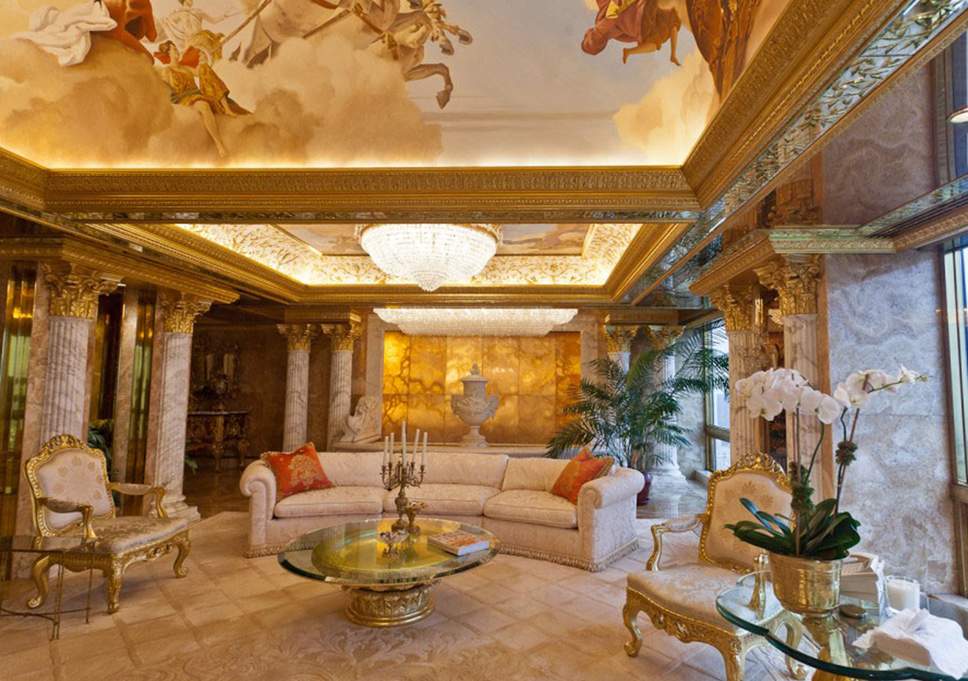Donald Trump's Lying Nature Defines His Design Tastes, Called 'Dictator Chic' By Peter York
/It's probably unrealistic to expect President Donald Trump to have read “Defining Deviancy Down,” the 1993 essay by the late New York Senator Daniel Patrick Moynihan, writes Mark A. Patterson for Politico. Much noted at the time, and remarkably prescient, Moynihan’s essay warned that Americans were seeing a decay in social behavior (for example, the rise in gun violence), and were becoming inured to it. Normalizing this behavior would eventually render America a less civilized society, Moynihan wrote.
Moynihan's argument rings true today. A quarter century later, big and small examples of our coarsening society are now normalized. The vulgar vitriol of commentary in social media and websites is appallingly coarse. The recent level of in the gutter accusations that were heard daily in the presidential elections continue to create new opportunities for therapists as citizens wrestle with America's new normal.
What would probably concern—and anguish—Moynihan most about Trump’s leadership is his systematic degradation of our societal institutions, from the courts to the media to agencies of his own government. Trump may or may not realize it, but his conduct in office is also diminishing the institution of the presidency itself.
Liar, Liar Pants on Fire!!
The ninth week of Donald Trump's presidency began with FBI Director James Comey calling him a liar, writes David Leonhardt. Let us be clear that Comey didn't use the 'l-word' in saying that there is "no information that supports" Trump's claim that former-president Barack Obama wiretapped his phones or ordered surveillance of Trump Tower.
Previously, Republicans and Democrats alike accused Trump of being careless with his words. He wasn't really lying, just as George W. Bush didn't deliberately lie when telling the nation that Iraq had weapons of mass destruction. Obama didn't deliberately lie when he said in relation to the ACA that people who liked their current health care plans could keep them in all cases. Bush and Obama were careless.
With Trump, we are in a new state of affairs and in this respect, our new president fulfills the total coarsening of civic institutions and regard for America's people anticipated by Sen. Monyihan's 1993 essay.
Trump sets out to deceive people, writes Leonhardt . As he has put it, “I play to people’s fantasies.”
Caveat emptor: When Donald Trump says something happened, it should not change anyone’s estimation of whether the event actually happened. Maybe it did, maybe it didn’t. His claim doesn’t change the odds.
Which brings us to Russia and FBI Director Comey's declaration on Monday that his intelligence group was investigating possible colusion between Russia and the Trump campaign. As Comey testified for all the world to observe, Trump Tweeted falsehoods about his testimony.
Observing such presidential misbehavior, there is nothing more to do but acknowledge that America's president is a big liar -- that he lies about everything and all the time. This need for over-the-top, decadent design artifice is fundamental to an autocrat's power over an insecure populace, writes Peter York, author of 11 books, including Dictator Style: Lifestyles of the World’s Most Colorful Despots'.
York puts his expertise to work in Politico Magazine, in an article titled 'Trump's Dictator Chic', a design lifestyle that is based on pure fakery, in the traditions of Las Vegas. A curator's eye spots all the manipulated falsehood's in Trump's interior design preferences.
A more sophisticated, educated and experienced eye sees the absence of architectural integrity in Trump's dictator chic. It's as deceptively empty as the truths of his Twitter account. To call it 'Dictator Chic' describes the first two month's of Trump's repulsive presidency. Who knew that York's design insights would so dead-on describe the Trump presidency to date.
Related: Donald Trump Has Been Lying About The Size Of His Penthouse Forbes May 16, 2018
Trump has worked for decades to cultivate his style and that of Trump brands, writes York. "The theme is success, wealth, winning, and the aesthetic is bright, brassy, loud—or, depending whom you ask, gaudy and fake. In person, the Trump look is that distinctive hair, oversized suits (apparently from the expensive Italian clothier Brioni) and long, shiny, red ties. Architecturally, it’s gilt and mirrors, as in his famous marble-and-gold Trump Tower apartment, photographed many times over the years, with its canopy beds, fresco-style ceilings and colossal chandeliers."
The look bears little resemblance to the tastes of wealthy or aspiring-to-be-wealthy Americans, past and present. But after spending months analyzing the style preferences of 16 strongmen Mexico’s Porfirio Díaz to Serbia’s Slobodan Milosevic, York was able to identifying 10 unifying 'dictator chic' rules.
When he first looked at images of Donald Trump's Trump Tower Manhattan penthouse, its occupant was unknown.
"They appeared to show a gigantic apartment in what looked, from the windows, very much like New York. But I know Manhattan and its sophisticated style pretty well, and at first glance, you would think the place didn’t belong to an American but to a Russian oligarch, or possibly a Saudi prince with a second home in the United States. There were overscaled rooms, and obviously incorrect-looking historical detailing and proportions. The home had lots of gilded French furniture and the strange impersonal look of a hotel lobby, with chairs and sofas placed uncomfortably far from one another. There were masses of gold; there were the usual huge chandeliers, branded relics of famous sportsmen like Muhammad Ali, and mushroom-colored marble floors. There was relatively little in the way of paintings, but otherwise, the place reeked of dictator chic."
In the summer of 2016, this man was one of two people who would become leader of the free world. No matter how you looked at it, the main thing this apartment said was, “I am tremendously rich and unthinkably powerful.” This was the visual language of public, not private, space. Read on at Politico in this incredibly interesting article for design lovers wanting to understand the rules of taste among despots.





